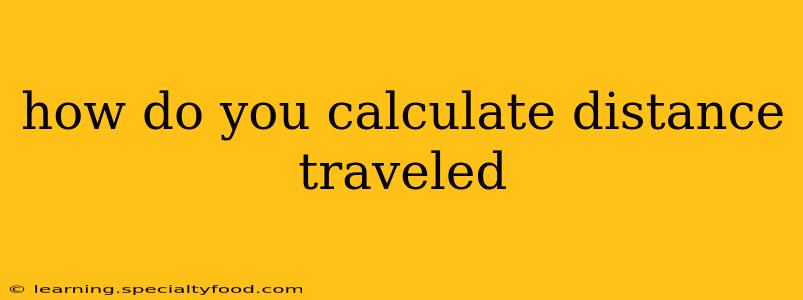How Do You Calculate Distance Traveled?
Calculating distance traveled depends heavily on the type of movement and the information available. There's no single formula; the method varies depending on whether you're dealing with a straight line, a curved path, or a journey involving multiple legs. Let's explore different scenarios and the corresponding calculations.
1. Straight-Line Distance:
This is the simplest case. If an object moves in a straight line, the distance traveled is simply the difference between its starting and ending positions.
-
Formula: Distance = |Final Position - Initial Position| (The absolute value ensures a positive distance)
-
Example: A car travels from kilometer marker 10 to kilometer marker 25 along a straight highway. The distance traveled is |25 - 10| = 15 kilometers.
2. Distance with Constant Speed and Time:
If you know the constant speed of an object and the time it traveled, you can calculate the distance using the following:
-
Formula: Distance = Speed × Time
-
Example: A train travels at a constant speed of 60 miles per hour for 3 hours. The distance traveled is 60 mph × 3 hours = 180 miles.
3. Distance with Changing Speed:
When speed isn't constant, things get a bit more complex. You need to consider the speed at different intervals of time. Here are two common approaches:
-
a) Average Speed Method (Approximation): If you have an overall average speed, you can use the same formula as above (Distance = Average Speed × Time). However, this is an approximation and works best when the speed variations are relatively small.
-
b) Calculus (Precise Calculation): For accurate calculations with continuously changing speed, integral calculus is necessary. The distance is the integral of the speed function over the time interval. This is typically used in physics and engineering.
4. Calculating Distance from GPS Data or Maps:
For real-world journeys, mapping applications and GPS devices are invaluable. They can track your path and calculate the total distance traveled, accounting for curves and turns. These tools often use sophisticated algorithms to determine distances based on the Earth's curvature.
5. Distance in Multiple Legs:
If a journey involves multiple legs (e.g., driving to a store, then to the post office), you calculate the distance of each leg separately and then add them together to get the total distance.
How do you calculate the distance traveled by a vehicle?
This is typically done using one of the methods mentioned above. For a simple journey with a relatively constant speed, the Speed x Time formula suffices. For more complex journeys with changing speeds, GPS devices or mapping applications provide the most accurate measurements. Odometers in vehicles also record distance traveled, but their accuracy can vary.
How do I calculate distance traveled from speed?
You can't calculate distance from only speed. You also need the duration of travel (time). Use the formula: Distance = Speed × Time. Remember that this formula assumes a constant speed. If the speed varies, more advanced techniques (as discussed above) are required.
What is the formula for calculating distance?
There isn't one single formula. The appropriate formula depends on the context: straight-line motion, constant speed, changing speed, or using tools like GPS. The most common formula is Distance = Speed × Time (for constant speed).
Understanding the context and the available information is crucial for selecting the correct method to accurately calculate the distance traveled. Remember to use appropriate units (meters, kilometers, miles, etc.) throughout your calculations to ensure consistent results.
